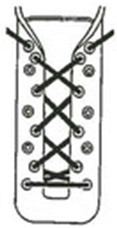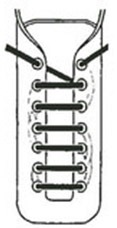Did you know that shoe lacing techniques could prevent injuries, alleviate pain and relieve foot problems?
Here are Foot Medical Centre’s recommended lacing techniques to help ensure your shoes fit properly and accommodate your foot conditions. Whether you have narrow, wide, or high arched feet, or if you are experiencing foot pain, a change to your lacing technique may help you.

Narrow Feet – Cross Lace
If you have narrow feet, consider using the outer eyelets of the shoe. This will allow the sides of the shoe to hug your narrow feet for a better tighter and more comfortable fit.

Wide Feet – Cross Lace
If you have wide feet, consider using the inner eyelets of the shoe. Using the inner eyelets will give more width to the top of the shoe to accommodate a wider foot.

Narrow Heel and Ankle with a Wide Forefoot
If you have a narrow heel and ankle with a wide forefoot, consider using two laces per shoe to achieve a combination fit. Use the inner eyelets to achieve a wider fit in your forefoot and the outer eyelets to achieve a narrower fit around your heel and ankle. The laces can also be tied looser around your forefoot while tied tighter around your ankle for a comfortable fit.

Pain On The Top Of The Foot – Skip Lace
If you experience pain on the top of your foot due to a high arch, a bone that sticks out, arthritis, a damaged nerve, a tendon injury or a skin lesion, consider skipping the eyelet(s) in the region of the foot. This reduces the pressure to that aspect of the foot, and will greatly increase the comfort of your shoes.

High Arches – Ladder Lace
If you have high arches, consider lacing your shoes so that the laces lie parallel to each other, from eyelet to eyelet. By avoiding the Cross Lace method, this method eliminates focal pressure points at the laces to accommodate a high arched foot.

Toe Problems / Tender Toes
If have hammer toes, claw toes, mallet toes, or painful toes associated with corns, calluses or ingrown toenails, consider lacing your shoes so that the toe box section is lifted and roomier. With this method, you can adjust the height of the toe box by pulling on the right lace; which travels directly from the toe box to the top of the shoe.

Heel Slippage (Pistoning)
To prevent heel pistoning, which may lead to painful blisters, you can try this lacing technique. Start off with a simple Cross-Lace technique. Once at the second last eyelet, do not cross over. Rather, put the lace into the last eyelet on the same side (creating a little loop). Once complete on each side, run the free end under the loop of the opposite side and fasten to comfort.

